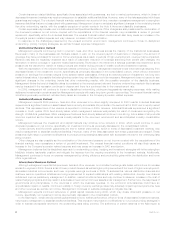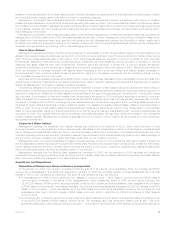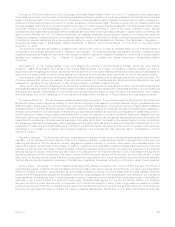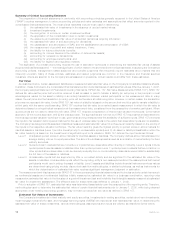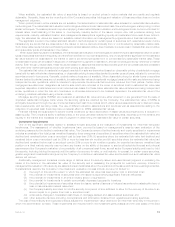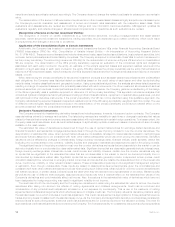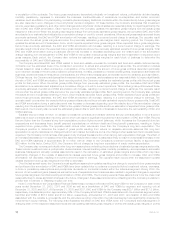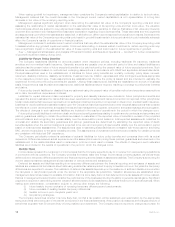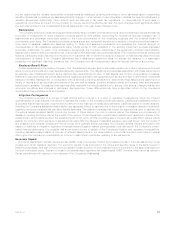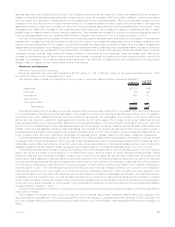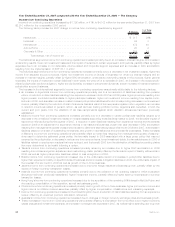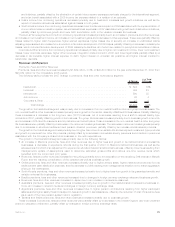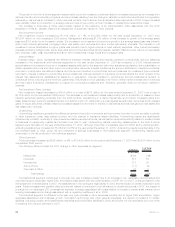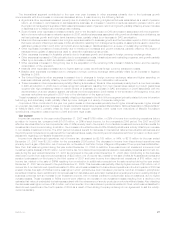MetLife 2008 Annual Report Download - page 21
Download and view the complete annual report
Please find page 21 of the 2008 MetLife annual report below. You can navigate through the pages in the report by either clicking on the pages listed below, or by using the keyword search tool below to find specific information within the annual report.When testing goodwill for impairment, management also considers the Company’s market capitalization in relation to its book value.
Management believes that the overall decrease in the Company’s current market capitalization is not representative of a long-term
decrease in the value of the underlying reporting units.
Management applies significant judgment when determining the estimated fair value of the Company’s reporting units and when
assessing the relationship of market capitalization to the estimated fair value of its reporting units and their book value. The valuation
methodologies utilized are subject to key judgments and assumptions that are sensitive to change. Estimates of fair value are inherently
uncertain and represent only management’s reasonable expectation regarding future developments. These estimates and the judgments
and assumptions upon which the estimates are based will, in all likelihood, differ in some respects from actual future results. Declines in the
estimated fair value of the Company’s reporting units could result in goodwill impairments in future periods which could materially adversely
affect the Company’s results of operations or financial position.
Management continues to evaluate current market conditions that may affect the estimated fair value of the Company’s reporting units
to assess whether any goodwill impairment exists. Continued deteriorating or adverse market conditions for certain reporting units may
have a significant impact on the estimated fair value of these reporting units and could result in future impairments of goodwill.
See “— Management’s Discussion and Analysis of Financial Condition and Results of Operations — Goodwill” for further consideration
of goodwill impairment testing during 2008.
Liability for Future Policy Benefits
The Company establishes liabilities for amounts payable under insurance policies, including traditional life insurance, traditional
annuities and non-medical health insurance. Generally, amounts are payable over an extended period of time and related liabilities are
calculated as the present value of future expected benefits to be paid reduced by the present value of future expected premiums. Such
liabilities are established based on methods and underlying assumptions in accordance with GAAP and applicable actuarial standards.
Principal assumptions used in the establishment of liabilities for future policy benefits are mortality, morbidity, policy lapse, renewal,
retirement, disability incidence, disability terminations, investment returns, inflation, expenses and other contingent events as appropriate
to the respective product type. These assumptions are established at the time the policy is issued and are intended to estimate the
experience for the period the policy benefits are payable. Utilizing these assumptions, liabilities are established on a block of business
basis. If experience is less favorable than assumptions, additional liabilities may be required, resulting in a charge to policyholder benefits
and claims.
Future policy benefit liabilities for disabled lives are estimated using the present value of benefits method and experience assumptions
as to claim terminations, expenses and interest.
Liabilities for unpaid claims and claim expenses for property and casualty insurance are included in future policyholder benefits and
represent the amount estimated for claims that have been reported but not settled and claims incurred but not reported. Other policyholder
funds include claims that have been reported but not settled and claims incurred but not reported on life and non-medical health insurance.
Liabilities for unpaid claims are estimated based upon the Company’s historical experience and other actuarial assumptions that consider
the effects of current developments, anticipated trends and risk management programs, reduced for anticipated salvage and subrogation.
The effects of changes in such estimated liabilities are included in the results of operations in the period in which the changes occur.
Future policy benefit liabilities for minimum death and income benefit guarantees relating to certain annuity contracts and secondary and
paid up guarantees relating to certain life policies are based on estimates of the expected value of benefits in excess of the projected
account balance and recognizing the excess ratably over the accumulation period based on total expected assessments. Liabilities for
universal and variable life secondary guarantees and paid-up guarantees are determined by estimating the expected value of death
benefits payable when the account balance is projected to be zero and recognizing those benefits ratably over the accumulation period
based on total expected assessments. The assumptions used in estimating these liabilities are consistent with those used for amortizing
DAC, and are thus subject to the same variability and risk. The assumptions of investment performance and volatility for variable products
are consistent with historical S&P experience.
The Company periodically reviews its estimates of actuarial liabilities for future policy benefits and compares them with its actual
experience. Differences between actual experience and the assumptions used in pricing these policies, guarantees and riders and in the
establishment of the related liabilities result in variances in profit and could result in losses. The effects of changes in such estimated
liabilities are included in the results of operations in the period in which the changes occur.
Income Taxes
Income taxes represent the net amount of income taxes that the Company expects to pay to or receive from various taxing jurisdictions
in connection with its operations. The Company provides for federal, state and foreign income taxes currently payable, as well as those
deferred due to temporary differences between the financial reporting and tax bases of assets and liabilities. The Company’s accounting for
income taxes represents management’s best estimate of various events and transactions.
Deferred tax assets and liabilities resulting from temporary differences between the financial reporting and tax bases of assets and
liabilities are measured at the balance sheet date using enacted tax rates expected to apply to taxable income in the years the temporary
differences are expected to reverse. The realization of deferred tax assets depends upon the existence of sufficient taxable income within
the carryback or carryforward periods under the tax law in the applicable tax jurisdiction. Valuation allowances are established when
management determines, based on available information, that it is more likely than not that deferred income tax assets will not be realized.
Factors in management’s determination consider the performance of the business including the ability to generate capital gains. Significant
judgment is required in determining whether valuation allowances should be established, as well as the amount of such allowances. When
making such determination, consideration is given to, among other things, the following:
(i) future taxable income exclusive of reversing temporary differences and carryforwards;
(ii) future reversals of existing taxable temporary differences;
(iii) taxable income in prior carryback years; and
(iv) tax planning strategies.
The Company determines whether it is more likely than not that a tax position will be sustained upon examination by the appropriate
taxing authorities before any part of the benefit is recorded in the financial statements. A tax position is measured at the largest amount of
benefit that is greater than 50 percent likely of being realized upon settlement. The Company may be required to change its provision for
18 MetLife, Inc.


